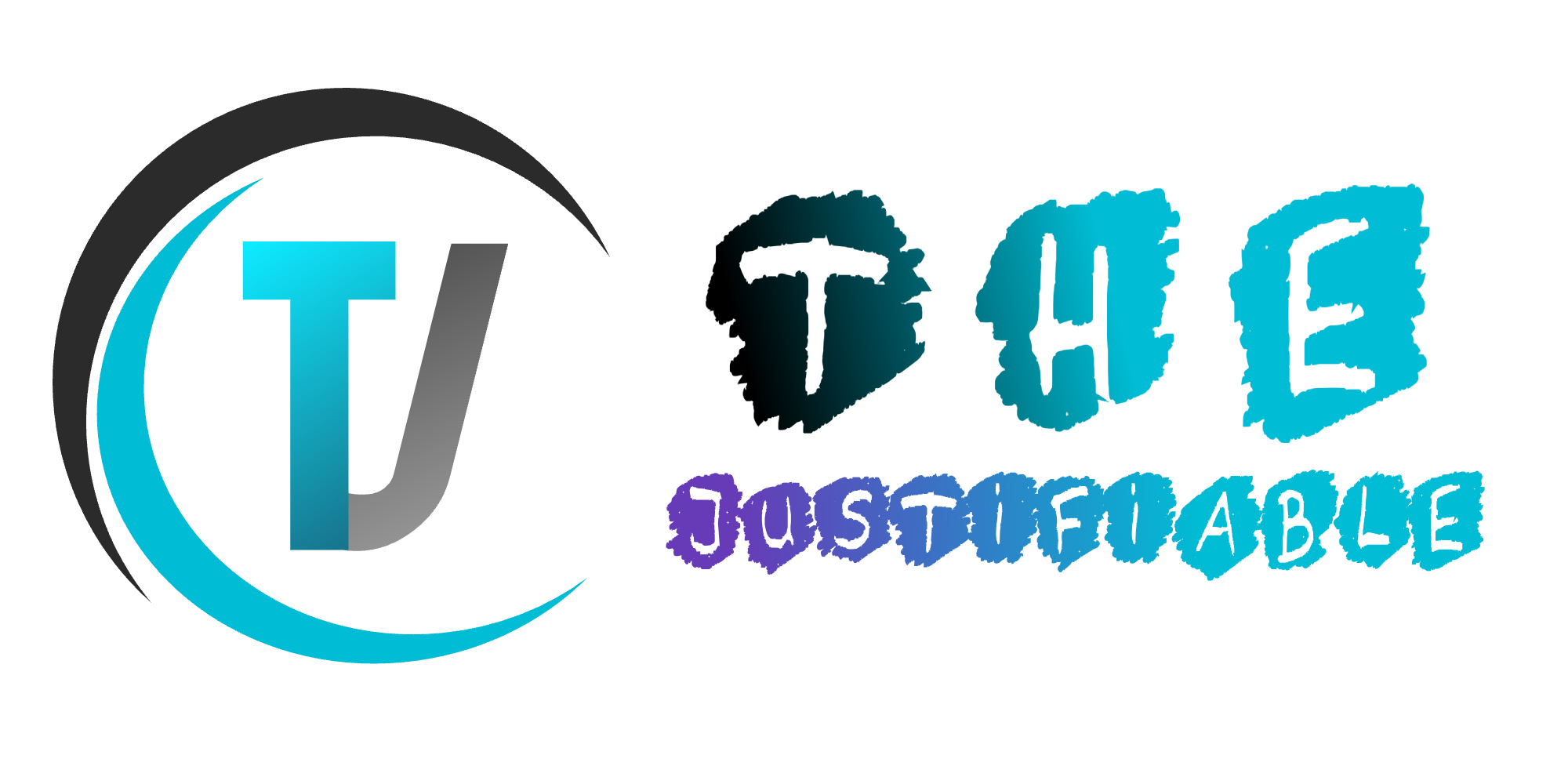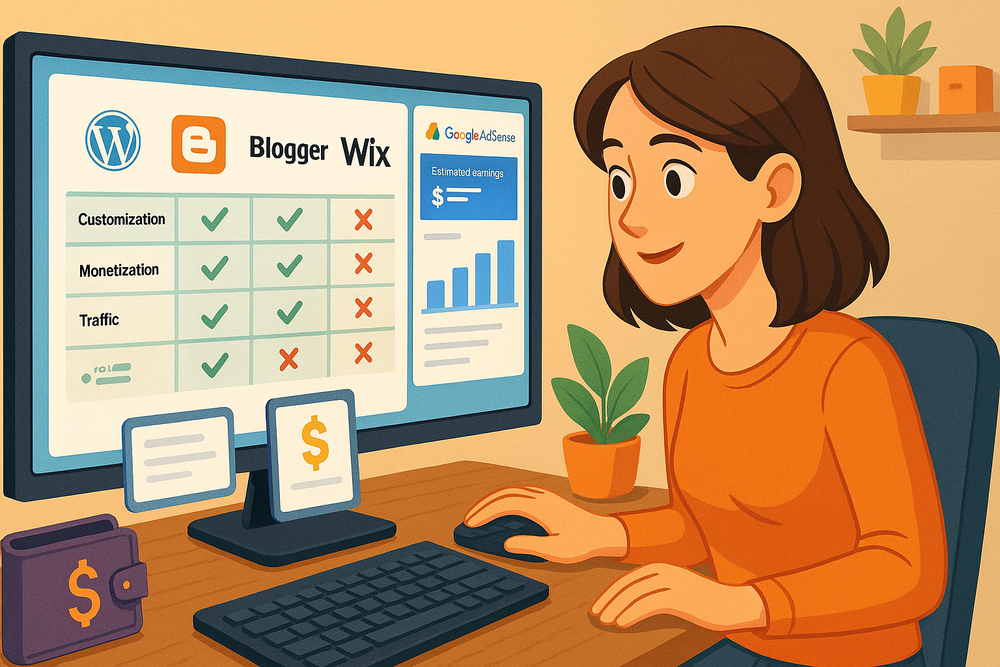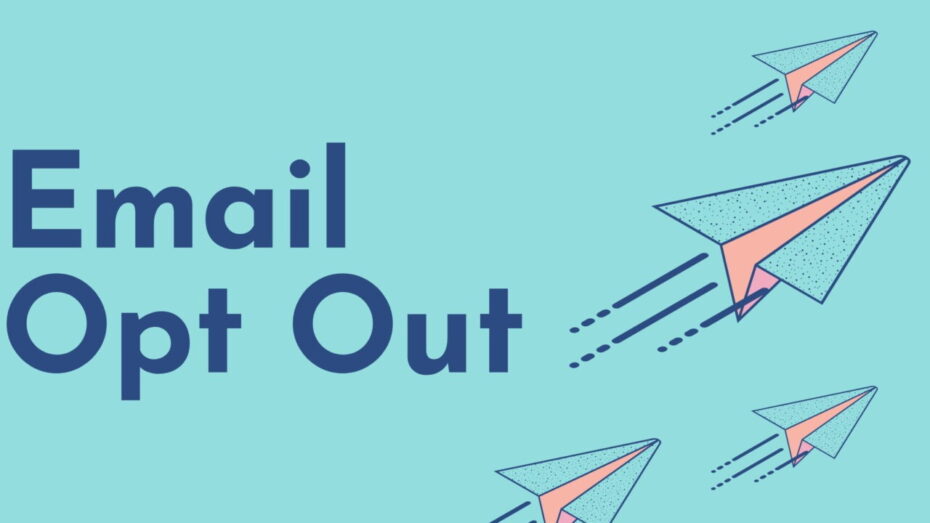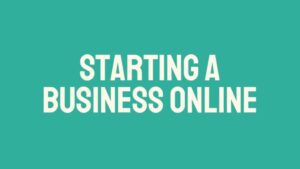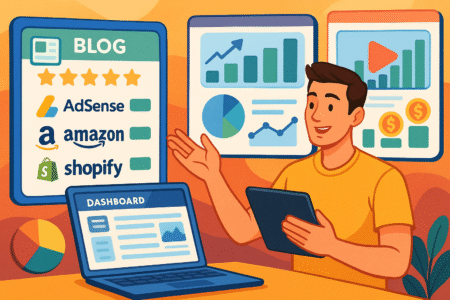Table of Contents
Can you really start a blog for free and make money fast, or is that just another internet myth? Plenty of people wonder if they need to invest upfront, how quickly they can monetize, and whether free platforms even give them a fair shot at success.
The truth is, you can launch a blog without spending a dime, but the speed of making money depends on the choices you make early on.
In this guide, I’ll break down the best free blogging platforms, the fastest monetization strategies, and what steps you need to take if you want your blog to start earning quickly.
Best Free Platforms To Start A Blog That Can Earn
You don’t need to spend money upfront to get a blog off the ground. The platform you choose shapes how quickly you can grow and monetize.
Choose WordPress.com For A Beginner-Friendly Setup
WordPress.com makes blogging accessible without requiring coding knowledge. The free plan gives you hosting, security, and a ready-to-use editor. The dashboard is clean—click “Add New Post,” type, hit publish, and you’re live. You can also pick from dozens of free themes to match your style.
The catch? You’ll be limited to a WordPress-branded domain like yourblog.wordpress.com, and plugins are locked behind paid tiers. But if your main goal is to start writing immediately and test if blogging feels right for you, I’d say WordPress.com is the safest bet. I’ve seen beginners publish their first posts within an hour of signing up.
Use Blogger For A Simple And Quick Launch
Blogger is like a no-frills bicycle. It gets you moving without fancy gears. Owned by Google, it connects smoothly with AdSense, meaning you can technically start running ads once you have some traffic.
The customization is limited compared to WordPress, but Blogger’s simplicity is its strength. From the dashboard, you just click “New Post,” and you’re writing. If you’re more interested in sharing ideas than fiddling with design, Blogger still delivers.
Try Medium If You Want Built-In Readers
Medium works differently. You don’t technically own your blog, but you do get immediate access to an existing audience. Think of it as blogging inside a giant digital magazine.
You can join the Medium Partner Program and earn money when paying members read your posts. The upside: no need to worry about traffic in the beginning. The downside: your earning potential depends on Medium’s algorithms, not your own control. If fast exposure is your goal, it’s worth experimenting with.
Consider Wix For Design Flexibility Without Coding
Wix is all about drag-and-drop design. Want a custom-looking blog without touching HTML? Wix lets you snap elements into place visually. The free plan includes hosting, a Wix subdomain, and stylish templates.
Monetization is possible but slightly limited on the free tier. Still, if you’re someone who values aesthetics and wants a blog that feels more like a personal website, Wix gives you design freedom without the headache.
How To Make Money From A Free Blog Quickly
Once your blog is live, the next question is: how do you start earning from it fast? You don’t need to wait months if you pick the right monetization path.
Sign Up For Display Ads And Earn From Page Views
Platforms like Blogger integrate directly with Google AdSense, letting you display ads automatically. On WordPress.com, ads are available through WordAds once you meet traffic requirements.
The truth: ads won’t make you rich right away. With low traffic, you might see just a few dollars a month. But it’s passive income and a good motivator to keep publishing. I suggest viewing ads as a starter income stream rather than your main plan.
Use Affiliate Marketing For Fast Commissions
Affiliate marketing is the fastest way I’ve seen bloggers earn their first $50–$100. Sign up with networks like Flexoffers or Awin, grab unique product links, and weave them naturally into posts.
For example, if you’re reviewing budget-friendly laptops, you can link to them on Aliexpress. When someone clicks and buys, you earn a cut. The key is writing content that matches buying intent—like “best laptops under $500” instead of just “my laptop experience.”
Offer Digital Products Or Services With Zero Cost
One overlooked strategy is selling your own digital products. Think simple: PDF guides, templates, or checklists you can create in Google Docs or Canva. Offering services like freelance writing or coaching from your blog is another zero-cost option.
I’ve watched new bloggers land $100+ gigs just from a single “Work With Me” page. No ads, no affiliates—just direct offers. If you’re good at something, monetize it directly.
Monetize With Sponsored Content Once You Gain Traffic
Brands love working with niche bloggers, even small ones. Once you hit a few thousand monthly views, you can pitch companies for sponsored posts. They’ll pay you to review or feature their products.
I suggest starting with affiliate marketing and digital products while your traffic is small, then shifting into sponsorships once you have proof of an engaged audience.
Steps To Drive Traffic To A Free Blog Fast
Traffic is the fuel for every monetization strategy. A free blog can grow quickly if you use smart traffic-building tactics from the beginning.
Leverage Social Media Platforms For Immediate Reach
Don’t wait for Google. Share every post on platforms like TikTok, Twitter, and Pinterest. Pinterest, in particular, works like a search engine—your pins can drive consistent traffic for months.
I advise creating 2–3 unique visuals for each blog post using free Canva templates. Share them in relevant groups or communities where your target readers hang out. This gets eyes on your content from day one.
Write SEO-Friendly Content That Ranks Quickly
SEO (search engine optimization) is how you get free traffic from Google. On free platforms, you can still optimize. Use tools like Ubersuggest to find long-tail keywords, then include them in your title, intro, and headings naturally.
For example, instead of writing “My Blogging Journey,” use “How To Start A Blog For Free And Make Money.” That way, searchers can actually find your post. Even one post ranking for a low-competition keyword can bring daily readers.
Use Guest Posting To Borrow Established Audiences
Guest posting is a shortcut to visibility. Find blogs in your niche that accept contributors, pitch them an idea, and link back to your free blog in your bio. This sends both traffic and credibility your way.
When I started, one guest post on a mid-sized blog sent me over 300 visitors in a single day—way more than my own blog could have done at that stage.
Build An Email List Early To Retain Readers
Even with a free blog, you can use tools like Mailerlite or Aweber free plan to start collecting emails. Offer a freebie—a checklist, mini guide, or newsletter signup—to capture readers.
Email keeps your audience engaged even if algorithms shift. A single email blast can bring more traffic than a week of waiting for SEO. That’s why I recommend starting email capture from the very first post.
Common Challenges Of Free Blogging And Solutions
Starting for free is smart, but you’ll face limits along the way. The good news: almost every challenge has a workaround if you know where to look.
Work Around Limited Customization And Features
Free blogging platforms usually keep advanced features locked behind a paywall. You might not be able to install plugins, change themes deeply, or add custom code. This can make your blog feel generic if you’re not careful.
The workaround is simple: focus on what you can control. Most free platforms let you tweak colors, fonts, and layouts within their built-in themes. If you’re on WordPress.com, head to Appearance > Customize, and you’ll find options to make small but powerful adjustments. Even something like swapping your header image or adjusting spacing makes your blog look more personal.
I also suggest using free external tools to extend functionality. For example, you can embed forms from Google Forms or Jotform, use Canva for custom graphics, and connect Mailerlite with a simple embed code for email signups. These little hacks give your blog a “pro” feel without needing premium features.
Overcome Domain Restrictions That Hurt Branding
One of the biggest frustrations is being stuck with a subdomain like yourblog.wordpress.com or yoursite.blogspot.com. It’s fine for starting out, but it doesn’t scream credibility when you’re pitching to readers or brands.
My advice: don’t stress about it in the first 3–6 months. Use this time to build content and traffic while keeping the free domain. Once you’re confident blogging is right for you, upgrade to a custom domain name (usually $10–$15 per year). This small step instantly upgrades your branding.
Think about it: would you trust bestfitnessgear.com more than bestfitnessgear.wordpress.com? Readers do too. Start free, prove your consistency, then buy your domain when you’re ready to grow.
Solve Monetization Limits On Some Free Platforms
Not all free platforms give you equal freedom to make money. For example, WordPress.com doesn’t allow third-party ads or certain affiliate programs unless you’re on a paid plan. Medium locks you into their Partner Program.
The solution is diversification. Even if your platform restricts ads, you can still do affiliate marketing, digital products, or freelance services. If you’re on Blogger, take advantage of its direct AdSense integration. If you’re on Medium, lean into their audience-first model.
One trick I often use: set up a simple landing page on a separate free tool like Carrd or Notion to promote products or services. Link to it from your blog, bypassing monetization restrictions.
Prevent Losing Content Control With Platform Rules
When you blog on a free service, you’re technically playing in someone else’s sandbox. If WordPress.com or Medium changes policies, your blog could be restricted—or worse, taken down.
That’s why I recommend always backing up your content. On WordPress.com, you can export posts under Tools > Export. On Medium, copy your posts into Google Docs as a safeguard.
Long-term, the solution is moving to self-hosted blogging once you’re serious. But while you’re still free blogging, just remember: your words are valuable, so protect them like assets.
When To Move From Free To Paid Blogging For Growth
There’s a point where free tools start holding you back. If you want to grow your blog into a true income source, investing in upgrades is the logical next step.
Upgrade To A Custom Domain For Professional Appeal
The first upgrade worth every penny is a custom domain. It’s a small expense but creates a big shift in perception. For example, if you start with cookingtips.wordpress.com and later switch to cookingtips.com, your brand immediately feels more trustworthy.
Most platforms make this upgrade seamless. On WordPress.com, go to Settings > Domains > Add Domain. On Blogger, you can connect a purchased domain in Settings > Publishing. From personal experience, I’ve noticed brands respond more positively to collaboration pitches once the “.wordpress” or “.blogspot” is gone.
Invest In Hosting For More Monetization Freedom
Free platforms cap your earning methods, but self-hosted WordPress.org removes those restrictions. Hosting usually costs $3–$10 a month, but it opens the door to unlimited customization, plugins, and monetization.
For example, if you want to install WooCommerce to sell digital products or set up advanced SEO plugins like RankMath, you’ll need hosting. I advise moving here once you know blogging isn’t just a hobby but a potential business.
Scale Faster With Premium Themes And Plugins
Premium themes give you polished designs that look like professional websites. Plugins add functionality like advanced SEO, faster loading times, or better email capture.
Think of it this way: free blogging is like cooking with basic utensils, while premium themes and plugins are the sharp knives and specialty pans that speed up the process. Once you’re making consistent progress, those tools help you scale without reinventing the wheel.
Transition To Paid Blogging Once Income Becomes Consistent
The best time to invest in paid blogging is when your blog is already making some money—even $20–$50 a month. That way, you’re reinvesting profits, not just gambling.
If you’ve hit a point where your traffic is steady, people are subscribing, and you’ve earned your first affiliate commission, it’s time to level up. Paid blogging tools don’t just make your blog look better—they give you the freedom to grow faster.
Pro Tips To Start A Blog For Free And Make Money Fast
You don’t need years to see results. With the right mindset and strategy, even a free blog can start earning quicker than you think.
Focus On One Monetization Strategy At A Time
The mistake most beginners make is trying to do everything at once—ads, affiliates, products, sponsorships. It spreads you too thin. Instead, pick one main strategy.
If you’re starting from zero, I suggest affiliate marketing. It’s simple, requires no inventory, and scales with traffic. Once you’ve mastered it, layer on additional streams. Focusing creates momentum.
Create Evergreen Content That Earns Long-Term
Evergreen content is timeless—it answers questions people always have. Posts like “How To Meal Prep For Beginners” or “Best Free Tools For Bloggers” will stay relevant for years.
I suggest creating a mix of trending topics for quick traffic and evergreen posts for steady growth. Over time, those evergreen articles become your blog’s backbone, bringing in consistent visitors (and income) even when you’re not actively posting.
Track Blog Performance With Free Analytics Tools
You can’t grow what you don’t measure. Google Analytics and Google Search Console are free tools that show you what’s working.
For instance, from the Analytics dashboard, go to Acquisition > Traffic > Source/Medium to see where visitors are coming from. If you notice 70% of your traffic comes from Pinterest, double down there. If a single blog post is ranking on Google, update and expand it regularly to maximize results.
Network With Other Bloggers To Speed Up Growth
Blogging feels less lonely when you connect with others—and collaborations drive growth. Join niche-specific Facebook groups, comment on similar blogs, and reach out for guest posting opportunities.
I’ve personally had moments where a single collaboration doubled my traffic for a week. Networking isn’t just about getting links; it’s about learning shortcuts and building a community that supports your growth.
Pro tip to wrap it all up: free blogging is the training ground, but how you approach it determines your speed. Treat your free blog like a professional project from day one—publish consistently, track results, and focus on building real connections with readers. The money follows that discipline.

